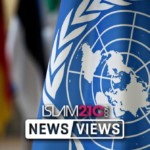The Prophet (sall Allāhu ʿalayhi wa sallam) said: “None of you truly believes until I am more beloved to him than his father, his child and all the people.”[1]
In this series we embark on a journey to increase our knowledge of the Prophet (sall Allāhu ʿalayhi wa sallam), to view him as the Sahāba viewed him, and to love him as we should.
Shamāʾil al-Muḥammadiyyah
Part 1 | Part 2 | Part 3 | Part 4 | Part 5 | Part 6
| 13. Qutaybah b. Saʿīd narrated to us that Layth b. Saʿd informed us that Abū az-Zubair reports that Jābir b. ʿAbdullāh (raḍiy Allāhu ʿanhu) said that the Messenger of Allāh (sall Allāhu ʿalayhi wa sallam) said,
The Prophets were presented to me, I saw Moses (ʿalayhi al-Salām), he was lean and well-built and resembled the tribe of Shanūʿah. I saw Jesus (ʿalayhi al-Salām) and the person I have seen who resembles him most is ʿUrwah ibn Masʿūd. I saw Abraham (ʿalayhi al-Salām) and the person who resembles him most is your companion – i.e. himself – I saw Gabriel and the person who resembles him the most is Diḥyā.[1] |
13- حدثنا قتيبة بن سعد قال، أخبرني الليث بن سعد، عن أبي الزبير، عن جابر بن عبد الله أن رسول قال:
عُرِضَ عَلَيَّ الأَنْبِياءَ، فَإِذا بِمُوسى (عَلَيهِ السَّلامُ) ضَرْبٌ مِنَ الرِّجالِ كَأَنَّهُ مِنْ رِجالِ شَنُوءَةَ، وَرَأَيتُ عِيسَى بن مَرْيَمَ (عليه السلام) فَإِذا أَقْرَبُ مَنْ رَأَيْتُ بِهِ شَبَهاً عُرْوَةُ بنُ مَسْعُودٍ، وَرَأَيْتُ إِبْراهِيمَ (عليه السلام) فَإِذا أَقْرَبُ مَن رَأَيْتُ بِهِ شَبَهاً صاحِبُكُم – يَعنِي نَفْسَهُ، وَرَأًيْتُ جِبْرِيلَ (عليه السلام) فَإِذا أَقْرَبُ مَن رَأَيْتُ بِهِ شَبَهاً دِحْيَةُ |
The Prophets were presented to me
This either happened in a dream or during the Night of al-Isrāʾ.[2] This indicates his superiority (sall Allāhu ʿalayhi wa sallam) over them because they were presented to him rather than the other way around. The Prophets are like his entourage and the entourage is presented to the master and not vice-versa. The meaning of the word Prophets here is general and encompasses the Messengers.[3]
I saw Moses (ʿalayhi al-Salām), he was lean and well-built and resembled the tribe of Shanūʿah
Ḍarb min al-rijāl: lean and not fleshy, of a fine build.[4]
Shanūʿah: a well-known Yemeni tribe known for being of moderate build, neither too thin nor too fat.[5]
Mūsā (ʿalayhi al-Salām) was of medium build without being fleshy, tall and (dark)[6] brown,[7] well built with lots of hair[8] that was curly.[9] Another narration describes him as being large (jasīm),[10] which is understood to be a reference to his height.[11]
I saw Jesus (ʿalayhi al-Salām) and the person I have seen who resembles him most is ʿUrwah b. Masʿūd
ʿUrwah b. Masʿūd (raḍiy Allāhu ʿanhu) accepted Islām in the ninth year of Hijrah after the Prophet (sall Allāhu ʿalayhi wa sallam) returned from Ṭāʾif. He returned to his people to call them to Islām, they refused however and he was killed while calling the adhān for prayer, or while calling them to Islām. Not much more is known of ʿUrwah so as to know how Jesus looked but Muslim has the ḥadīth describing Jesus (ʿalayhi al-Salām) as being “of medium build, red skinned as if he had just come out of a bath.”[12] Another ḥadīth mentions about him, “I saw a brown man, the best one can see amongst those of brown colour.”[13] Other ḥadīths describe him as having red-white skin with straight hair,[14] a lean and strong, well-proportioned build[15],[16] with a broad chest,[17] and keen eyes.[18]
The narrations concerning his skin colour can be reconciled by saying that he had a redness and a brownness, but neither was so dark as to be predominate, as such sometimes he was described as being red and other times as brown; or they can be reconciled by saying that he (sall Allāhu ʿalayhi wa sallam) saw him on two separate occasions in two different situations, his actual colour being brown and his being described as red on another occasion was due to some external factor, such as exertion or the likes.[19]
I saw Abraham (ʿalayhi al-Salām) and the person who resembles him most is your companion – i.e. himself
“i.e. himself,” are the words of Jābir or one of the other narrators of the ḥadīth. Another ḥadīth has, “I am the one who resembles Abraham the most amongst his children.” This resemblance was so strong that that every limb he looked at reminded him of himself.[20]
I saw Gabriel
Jibrīl (ʿalayhi al-Salām) has been mentioned here, amongst the Prophets, because of his frequently mixing in their company since he was responsible for conveying revelation to them, “and the person who resembles him the most is Diḥyā,” one of the senior Companions. He did not attend Badr but attended all the ensuing battles and was one of those who gave the pledge of allegiance under the tree. Similitudes would be propounded of him because of his great beauty. The two Ṣaḥīḥs mention that on occasion Jibrīl would come to the Messenger of Allāh (sall Allāhu ʿalayhi wa sallam) in the form of Diḥyā.[21]
| 14. Sufyān b. Wakīʿ and Muḥammad b. Bashshār narrated to us that Yazīd ibn Hārūn narrated that Saʿīd al-Jurayrī said he heard Abū al-Ṭufayl saying,
‘I have seen the Messenger of Allāh (sall Allāhu ʿalayhi wa sallam) and not a single person remains on the face of this earth who has seen him besides me.’ I said, ‘Describe him to me.’ He said, ‘He was white skinned, handsome, and of middle build and height.’[22] |
14- حدثنا سفيان بن وكيع ومحمد بن بشار (المعنى واحد) قالا، أخبر يزيد بن هارون، عن سعيد الجريري قال، سمعت أبا الطفيل يقول:
رَأَيْتُ النبيَّ وَما بَقِيَ عَلى وَجْهِ الأَرْضِ أَحَدٌ رَآهُ غَيرِي. قُلْتُ: صِفْهُ لِي. قالَ: كانَ أَبْيَضَ، مَلِيحاً مُقَصَّداً |
I have seen the Messenger of Allāh (sall Allāhu ʿalayhi wa sallam) and not a single person remains on the face of this earth
thereby excluding Jesus who saw him (sall Allāhu ʿalayhi wa sallam) while he was in the heaven, “who has seen him besides me,” meaning that he then is the most deserving of being asked about him (sall Allāhu ʿalayhi wa sallam) and encouraging others to ask after him (sall Allāhu ʿalayhi wa sallam).
This ḥadīth shows that he was the last of the Companions of the Messenger of Allāh (sall Allāhu ʿalayhi wa sallam) to die. He saw the Prophet (sall Allāhu ʿalayhi wa sallam) during the last eight years of his life, and passed away in the year 110AH according to the correct opinion.[23] This accords to the words of the Prophet (sall Allāhu ʿalayhi wa sallam), a month before his passing away, “There is no breathing soul on this earth that will be alive in one hundred years’ time.” Another narration mentions that towards the end of his life, the Prophet prayed ʿIshā after which he stood and said, “Do you see this night of yours? In one hundred years, there will not remain alive anybody who is alive on this earth today.”[24]
| 15. ʿAbdullāh b. ʿAbdur-Raḥmān narrated to us that Ibrāhīm b. al-Mundhir al-Ḥizāmī narrated to us that ʿAbdu-l-ʿAzīz b. Thābit az-Zuhrī narrated to us that Ismāʿīl ibn Ibrāhīm – the son of the brother of Mūsā b. ʿUqbah – narrates from Mūsā b. ʿUqbah; from Kurayb; from ibn ʿAbbās (raḍiy Allāhu ʿanhum) who said,
The Messenger of Allāh (sall Allāhu ʿalayhi wa sallam) had a gap between his incisors, when he spoke it was as if light was emanating from between his middle teeth.[25] |
15- حدثنا عبد الله بن عبد الرحمن، حدثنا إبراهيم بن المنذر الحزامي، حدثنا عبد العزيز بن ثابت الزهري، حدثني إسماعيل بن إبراهيم (بن أخي موسى بن عقبة) ، عن موسى بن عقبة، عن كريب عن ابن عباس قال:
كانَ رَسُولُ اللهِ أَفْلَجَ الثَّنِيَّتَينِ، إِذا تَكَلَّمَ رُؤِيَ كَالنُّورِ يَخْرُجُ مِن بَينِ ثنَاياهُ |
The Messenger of Allāh (sall Allāhu ʿalayhi wa sallam) had a gap between his incisors
al-falaj: refers to a gap between the incisors and the molars and al-faraq refers to a gap between the incisors, here al-falaj is employed with the meaning of al-faraq as proven by the context, this was stated by Ibn al-Athīr. However in al-Ṣiḥāḥ it is mentioned that al-falaj is used to refer to both types of gaps and as such one no longer stands in need of saying that one word has been used in place of another.[26]
When he spoke it was as if light was emanating from between his middle teeth
This was due to their extreme whiteness.[27] It could also mean something very white was seen that would glitter like light, this by way of a miracle for him (sall Allāhu ʿalayhi wa sallam),[28] however this ḥadīth is ḍaʿīf and miracles need to be established via authentic ḥadīth.
[donationbanner]
Source: www.islam21c.com
Notes:
[1] Muslim, Īmān #167 and Tirmidhī, Manāqib #3649.
[2] Haythamī, ʿAbbād
[3] Qārī
[4] Suyūṭī, Haythamī
[5] Qārī, Munāwī
[6] Aḥmad #3546, ar: asḥam
[7] Bukhārī, Anbiyāʾ #3394, Muslim #266
[8] Aḥmad #3546
[9] Bukhārī #5913, Muslim #267-270
[10] Aḥmad #2697
[11] Qārī
[12] Bukhārī, Anbiyāʾ #3394, 3437 and Muslim, Īmān #168
[13] Muslim, Īmān #169
[14] Bukhārī #3239, Muslim #267
[15] Aḥmad #3546
[16] Bukhārī #3395-3396, Muslim #266. Ar: jaʿd which in this context refers to the build of the body as opposed to having curly hair, and hence conforms to the description of him having straight hair. cf. Nawawī, Sharḥ Ṣaḥīḥ Muslim
[17] Aḥmad #2697
[18] Aḥmad #3546
[19] Qārī
[20] Aḥmad 1:347 #3546 from ibn ʿAbbās
[21] Bukhārī #4980, Muslim #271
[22] Muslim, Faḍāʾil #2340 and Abū Dāwūd, Adab #4864.
[23] Haythamī
[24] Bukhārī, ʿIlm #116, Mawāqīt al-Ṣalāh #564-601 and Muslim, Faḍāʾil al-Ṣaḥābah #2537-2538
[25] Ṭabarānī, al-Awsaṭ and al-Kabīr 11:416, Dārimī #59 and Bayhaqī 1:215.
Haythamī 8:279 said its isnād contains a ḍaʿīf narrator. Albānī: the isnād is ḍaʿīf jiddan.
[26] Qārī, Haythamī
[27] Haythamī
[28] Haythamī, Munāwī







